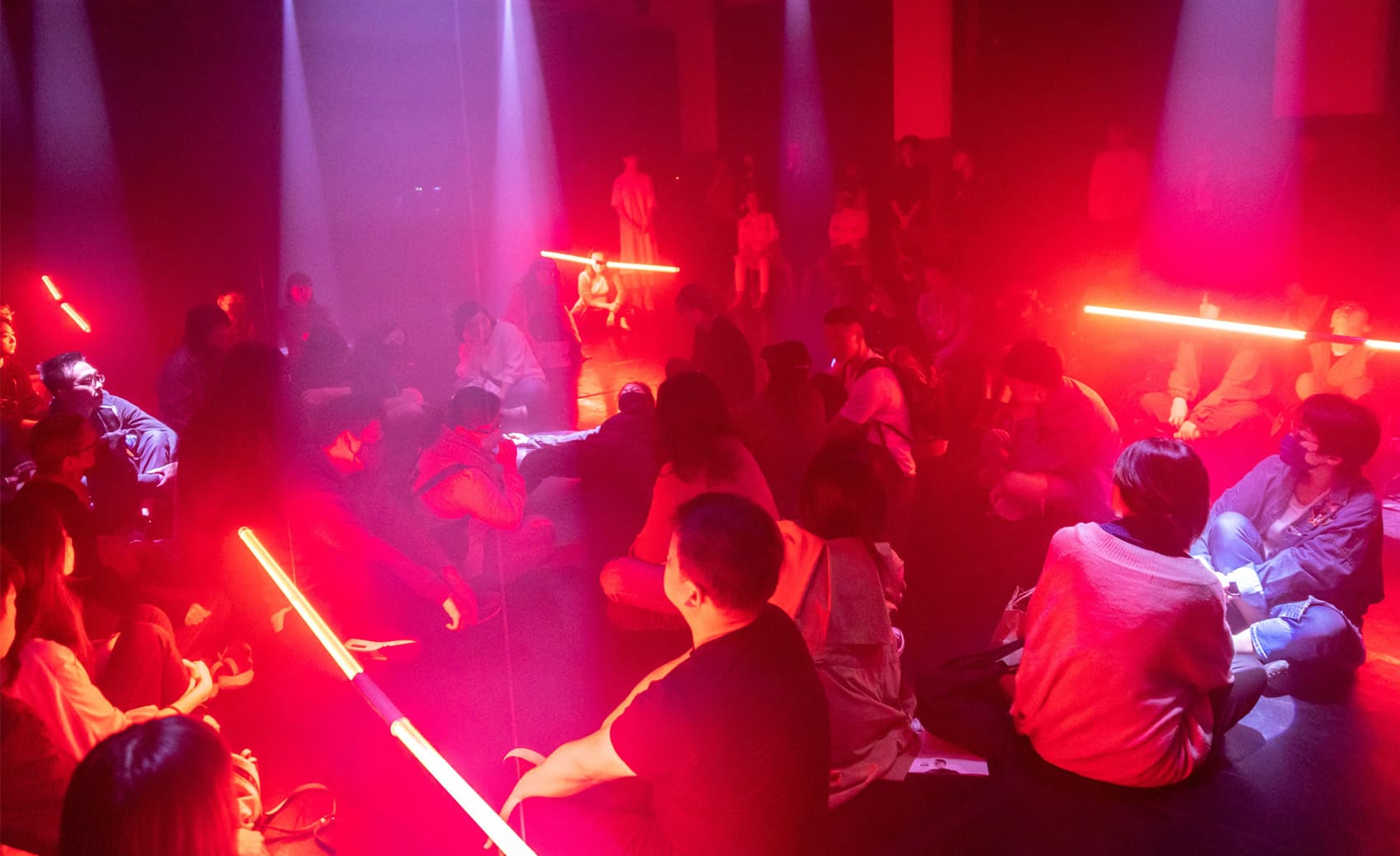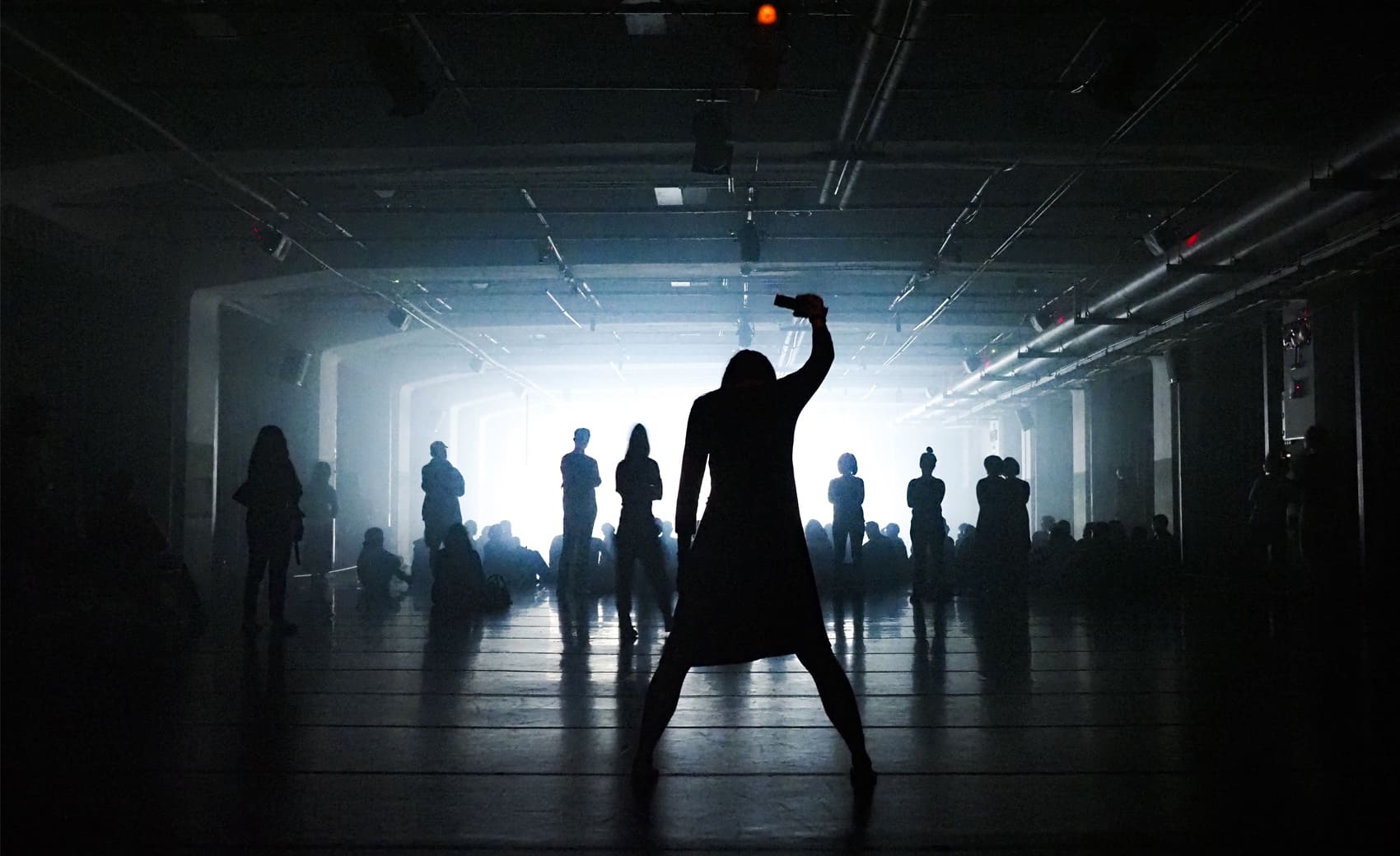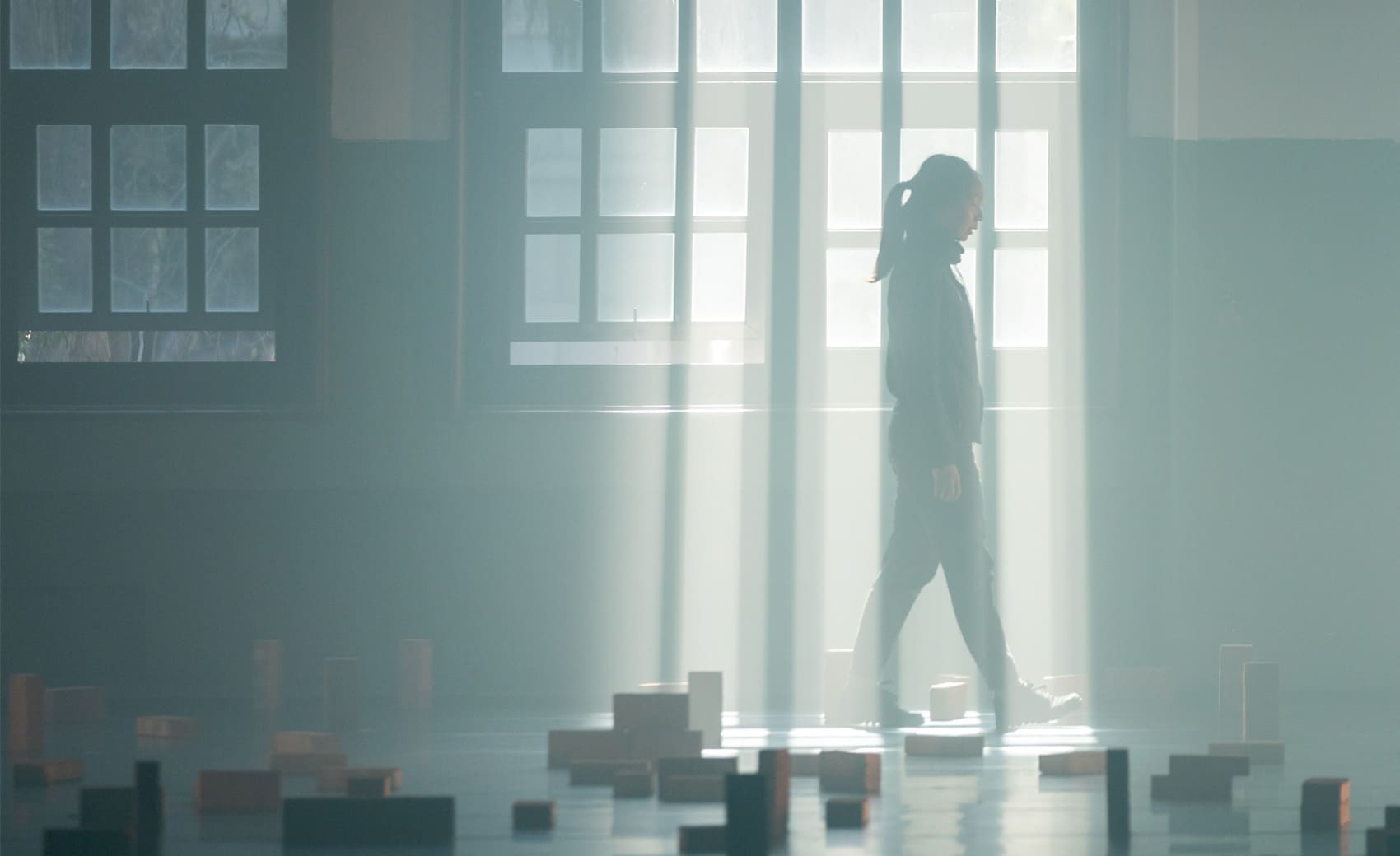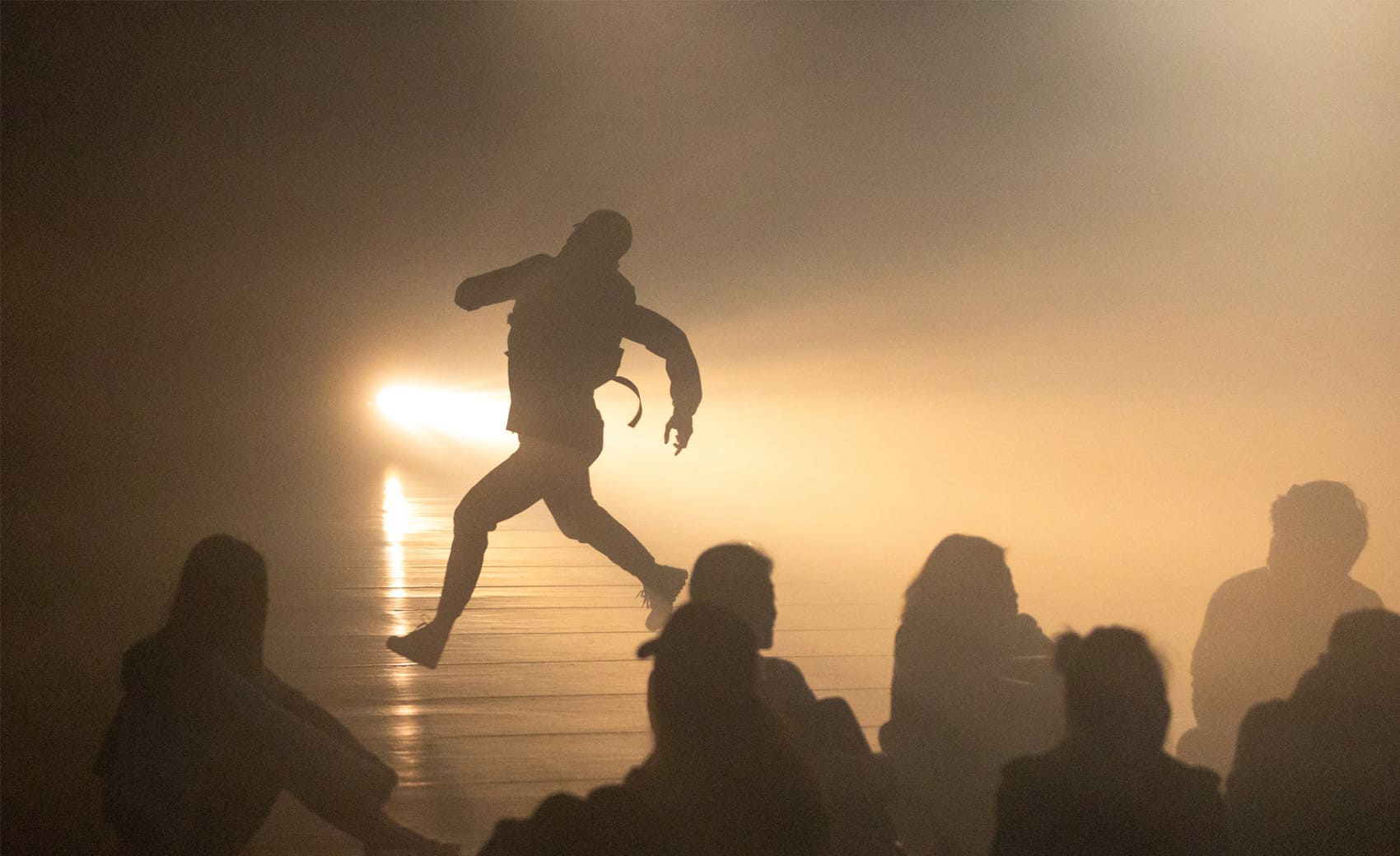由劇場導演王世偉主創,與編舞家田孝慈、聲音設計李慈湄、及燈光設計Helmi Fita共同完成的集體創作。作品勾勒社會運動的激情、混亂,以獨舞回應群體矛盾,深入抗爭者內在的複雜感知,詮釋個人於群眾運動中的悵然與孤寂。煙霧構成的不確定氛圍及詩意畫面、聲響給人的壓迫及衝擊,層層叩問個人、群體之間的交會與分離。表演者穿梭、環繞於觀眾之間,並將之從被動觀者化為主動參與者,透過多元的劇場效果,帶領觀眾重新回到社會運動的「心靈現場」。
With theatre director Wang Shih-Wei as the leading creator and collectively completed the work with choreographer Tien Hsiao-Tzu, sound designer Li Tzi-Mei and lighting designer Helmi Fita, Masses delineates the passion and chaos of social movements, responding to the conflicting feelings of the masses with solo dances that explore the complex emotions within the minds of protestors to interpret individual frustration and solitude in crowd movement. The smoke constitutes an uncertain ambiance and poetic visuality; the sound creates a sense of oppression and impact. Step by step, the performance questions the encounter and separation between individuals and the masses. As performers meander and move around the audience, who is turned into active participants from passive onlookers, the diverse theatrical effect of the work transports the audience back to the “psychological site” of social movements.
王世偉/主創、導演
國立臺北藝術大學戲劇系畢業,巴黎新索邦第三大學劇場藝術博士、碩士,鑽研歐陸劇場文化。從事書寫、翻譯、學術研究、文化交流,並持續發展藝術創作。譯有《舞臺書寫:解讀喬埃‧波默拉》,及《喬埃.波默拉的童話三部曲 劇本書:小紅帽.小木偶.灰姑娘》,舞台作品發表包括《林黛玉》、《窯‧臺》、《群眾》等。
田孝慈/編舞、舞者
國立臺灣藝術大學舞蹈系研究所畢業,現從事教學、創作與表演,曾與國內外重要編舞家與舞團合作,參與各大藝術節演出。個人創作發表於國家兩廳院微舞作、臺北藝術節、新人新視野、下一個編舞計畫、世紀當代舞團驅動城市系列、墨爾本Dance Massive舞蹈藝術節等。
李慈湄/聲音、音場設計
劇場音樂設計、音樂製作人、DJ。以當代聲音質性貼近臺灣文化、歷史與社會特色,努力打破音樂協助敘事的限制,突破符號性的聲音運用,創造不同的聆聽與理解經驗。劇場合作包括野孩子肢體劇場、壞鞋子舞蹈肢體劇場、差事劇團、演摩莎劇團等。
Helmi Fita/燈光、煙霧設計
劇場工作者,生於新加坡,在新加坡接受專業表演、藝術教學、燈光及技術舞臺訓練。從舞臺上淋漓盡致的表演者,轉變為舞臺下精心鋪陳場景與氛圍的設計者。現已從事劇場與教學工作29年。
WANG Shih-Wei / Creator, Director
Wang Shih-Wei graduated from the Department of Theater Arts, Taipei National University of the Arts, and later received his MA and PhD in Theatre Arts from the New Sorbonne University Paris III, France. He has focused on European theatre culture, delving in writing, translation, academic research, cultural exchange and artistic creation. His translation work includes the Mandarin version of Avec Joël Pommerat: Un monde complexe and Le Petit Chaperon Rouge,Pinocchio,Cendrillon; and his theatrical works include Blossom of the Fallen Flowers, Le Balcon and Masses.
TIEN Hsiao-Tzu / Choreographer, Dancer
Tien Hsiao-Tzu holds an MA in Dance from National Taiwan University of Arts, and is now a professional dance instructor, choreographer and dancer. She has collaborated with important choreographers and dance companies from Taiwan and abroad, and has taken part in various major arts festivals. Her works have been published in numerous occasions and programs, among which are National Theater & Concert Hall’s “Mix Program”; Taipei Arts Festival; Young Stars, New Vision; Next Choreography Project; and Century Contemporary Dance Company’s program, “RAM.”
LI Tzi-Mei / Sound and Acoustic Field Designer
Li Tzi-Mei is a theatrical music designer, music producer and DJ, who has endeavored in interpreting Taiwanese culture, history and society with the texture of contemporary sound while striving to shatter the limitation of using music to further narratives. By breaking the semiotic use of sound, she aims to create different experience of listening and understanding. She has worked with L'Enfant S. Physical Theatre, Bare Feet Dance Theatre, Assignment Theatre, Performosa Theatre and more.
Helmi Fita / Lighting and Smoke Designer
A theater professional, Helmi Fita was born in Singapore, where he received professional training in performance, art education, lighting and other stage techniques. He has changed his role from being a devoted performer on stage to a designer that works off stage to create elaborately designed setting and atmosphere. He has engaged in theatre and education for twenty-nine years.
王世偉
田孝慈
Helmi Fita
李慈湄
王序平
林家文
許俞苓
賴韋佑
賴韋豪
王庭悅
陳明佳、蔡承翰、許邵翔、馬翊淳
王弼正、王晧穎、張志偉、葉泓源、陳藝堂、劉振祥
松菸文創園區東向製菸工廠二樓LAB
關鍵字
- 凝視與參與
- 集體創作
- 劇場的當代性
- 社會運動的孤獨與矛盾
- 群體中個人意識的覺醒
藝術家談作品
若群眾運動像是一道道時代的浪,那推動也被推動著的、或遠或近的個人,又當被如何理解感知?
採訪及文字整理/許祐綸
或許未有特別覺察,但活在此刻的人們,都和不同群眾運動發生著關連。彼方香港抗爭未歇,島上六年前的學運遺緒至今牽動政治版塊。曾經我們在螢幕前看著煙霧彈拋擲、鳴笛震耳;在某個維持安全距離的運動外圍,席地相守;抑或,身處所謂前線,衝撞中見水車噴灑、血淚流淌。
重返運動中的心靈現場
若群眾運動像是一道道時代的浪,那推動也被推動著的、或遠或近的個人,又當被如何理解感知?《群眾》探測這距離遠近,嘗試描寫社會運動裡,個人的心靈樣態。導演主創王世偉,找來田孝慈編舞演出,加上Helmi Fita的煙霧燈光設計,以及李慈湄的音效聲場,共同創作。四人與社會運動淵源有別,有長年投入公民運動的李慈湄,318學運時首赴社運現場的田孝慈,以及新加坡成長、來台受公民能量觸動的Helmi;概念主創者王世偉,以法國六八學運為研究論文主題,幾個創作作品,也圍繞著革命與群眾運動展開。
2010年起,全球各地運動浪潮接連而至,在台灣,2014年318學運爆發,青年世代的覺醒帶來巨大影響,人在法國的王世偉參與留學生響應,但也思考著,個人意識覺醒,和運動裡群體的目標行動,或許未必等同。「研究六八運動後發現,很多法國人在運動後選擇自殺——個人命運承擔,跟群體如何開創集體命運,不一定是同件事。」創作計畫概念模糊成形,2016年,他與前往巴黎駐村的田孝慈初識,兩人合作的《群眾》初版誕生,然停留在運動語言與動作的牽制。王世偉想著如何更貼近自身思考,最後確定,若社會運動訴說的是群體的力量,那麼「以一個人的身體,在場上表現群眾中的孤獨」,便是下個版本《群眾》的核心。
以作品營造空間遠近與觀眾共振
王世偉回台,再與田孝慈重新發展動作身體,延續巴黎嘗試,以西班牙畫家哥雅(Francisco Goya)的系列版畫《戰爭的災難》(The Disasters of War)為素材,模擬各種抗爭與非抗爭身體,轉換拼貼,「這身體並非『樣態』,而是『動力』(momentum)」;同時,Helmi Fita及李慈湄各自從煙霧燈光與聲音著手,和王世偉尋找出有形無形材質的使用。
《群眾》上、下段落,先讓觀眾廣角遠觀抗爭中的個體,後拉近觀眾於結構內共感。一開始,田孝慈背負巨大空氣塑膠袋低身前進,穿越席地觀眾,在躁動的人聲及閃光中開始舞動。隨後,燈光全暗,她倏然拉開前方窗前布幕,濃濃煙霧隨即從霧室漫溢。一波波巨大聲響漸近包圍,她緩慢動作,做出各種如運動暗號的手勢;舞步疾緩間,隱約望見一旁透明雨傘靜置,她駐足傘前,似要伸手,隨即遠離。下段,不同人聲輪番流洩訴說自我,漸交雜難辨,此時,舞者現身觀眾後方,身著手套口罩,比劃手勢如暗語,隨後露出面容,走進人群,和觀眾雙手交握、時而並肩相坐如運動同伴。不久,她換穿黑色衣褲,似為抗爭整裝;歌聲夾雜噪音與節奏由遠而近,明暗光線中,舞者開始在場間奔跑,偶將觀眾身體拉近,鼓動眾人拍手。隨氛圍越發高漲,橘紅長型燈管緩降再升起,強烈閃爍與聲響震動體感。接之,燈光暗去,舞者身負霧面布條,奮力與身後力量抗衡前行,眼前似有長路鋪展,而背景諸多人聲再次出現,訴說自身對自由定義。舞作最末,田孝慈走向窗前,此時地面已立滿磚石路障,又似墳場;她將窗子一扇扇開啟後離去,僅留街聲,隨天光與煙霧繚繞。
團隊透過不同形式調性變化,營造意識遠近、感知觸動。Helmi的煙霧燈光經歷嘗試,「最後將手法盡可能簡化,透過來自劇場不同地方的燈光煙霧,把觀眾納入在作品當中。」李慈湄打破聲音的直接聯想,「將抗爭現場的聲音轉換,造成聽覺上的刺激與反應。」人聲部分則強化情緒編排,細膩鋪陳聲音聆聽脈絡。田孝慈則打破過往習慣的表演距離,走入觀眾,創造並肩共感,「我也將現場觀眾投射的回應,延續到下個動作之中,⋯⋯有了觀眾,才真正完成了這個作品。」
真實與抽象敘事間的符號距離拿捏
《群眾》誕生脈絡對應外在時局變化,創作過程恰逢香港抗爭爆發,作品如何汲取被運動觸動的哲思,卻不流於淺薄致敬,挑戰著團隊的清晰共識與謹慎辯證。王世偉直言,曾嘗試將符號物件移除,卻難以讓作品完整,「後來我們意識到,此時此刻發生的事,觀眾自然會產生聯想,但雨傘、黑衣褲、口罩、石塊,都是所有抗爭常見意象,我們不能否認這些符號的意義存在。」最終,「群眾」除了指涉社會運動,也擴延到其他群體,作品意象處理,也將如賽事現場、演唱會等概念涵納,「這擴大的想像,讓我們把單一符號性變成多元,間接產生忽遠忽近的距離感受,符號也被帶向更開闊深刻的構聯。」
《群眾》帶領觀眾抵赴個體的心靈現場,訴說著,即便群體的指向看似明確,個人在之中的覺醒、妥協、失落、迷惘,都非獨有,「因為,我們也在此中掙扎,我們也對這個世界共感。」萬眾前行,需無盡的獨步邁開,而所有存在,有其通同樣態,從未孤身無依。
評審談作品
由遠觀欣賞到近身相伴,邀請觀眾鼓勇面對社會運動中,幽微的個人生命情境,在激昂對抗與孤獨壓抑之間,召喚繼續堅持的希望。
第18屆 台新藝術獎 表演藝術獎 得獎理由
王世偉主創的《群眾》集結優秀藝術家,發揮豐沛創作能量,精彩實踐集體創作,整體製作完整卓越,並能充分運用空間潛能;由遠觀欣賞到近身相伴,邀請觀眾鼓勇面對社會運動中,幽微的個人生命情境,在激昂對抗與孤獨壓抑之間,召喚繼續堅持的希望。演出真摯動人,並能從獨特視角,切入審視個人在群體中的自我意識,激情、疏離,又不落入政治表態窠臼,謹慎避免沈溺自憐,回應騷動的全球局勢,體驗並重新省思抗爭之個人與社會意義。
Jury’s Comments for the Performing Arts Award
Wang Shih-Wei’s Masses is a collective performance featuring abundant creative energies of four outstanding artists. The production fully exploits the spatial potential of the venue. Watching from afar or immersed in close range, the audience is invited to bravely face the nuances of personal life amid street protests. Caught in between fierce confrontation and solitary repression, the sole protester calls for hope to persist. The performance sincerely examines the self-awareness, passion and alienation of individuals in the mass, without falling into the cliché of blatant political statement or self-indulgence. While responding to the global unrest, Masses takes the audience to re-experience and re-think the personal and the social of being in a street struggle.
入圍理由
孤寂卻堅毅的舞者身影在朦朧中現身,與空間裡的靜止之(觀)眾互為對應,是個體存在也是集體意識,是反抗也是壓抑,以此回應騷動的全球局勢,我們又能以何種姿態自處。舞蹈、聲音、燈光、煙霧各環節表現突出卻不突兀,恰如其分地鋪陳了包覆式的感官衝擊與辯證思考。《群眾》沒有政治表態,也非自我獨白,反以現場事件為背景素材,召喚著隱約留存的身體記憶,共振於末梢的激情與疏離,讓觀者得以用一種新的方式,重新經驗外面世界尚未止息的抗爭場景。 (主筆/白斐嵐)
Comments on the Finalist
The solitary but determined figure of the dancer appears in blurriness, contrasting to the still mass (audience) in the space—a scene of individual existence and collective awareness as well as resistance and repressiveness. It echoes the unstable global situations and seems to ask: how should we situate ourselves? Every link of the performance – the dance, the sound, its lighting and the smoke – is prominent yet unobtrusive, properly unfolding an encompassing sensory impact and dialectic thinking. Masses reveals no political statements; neither is it a self-revealing monologue. Instead, it employs what happens in the performance as material to evoke the implicit, residual body memory, resonating through the peripherals with both passion and aloofness. In a new way, the audience is therefore able to re-experience the unsettled scenes of protests in the outside world. (Commentator: Siraya PAI)








